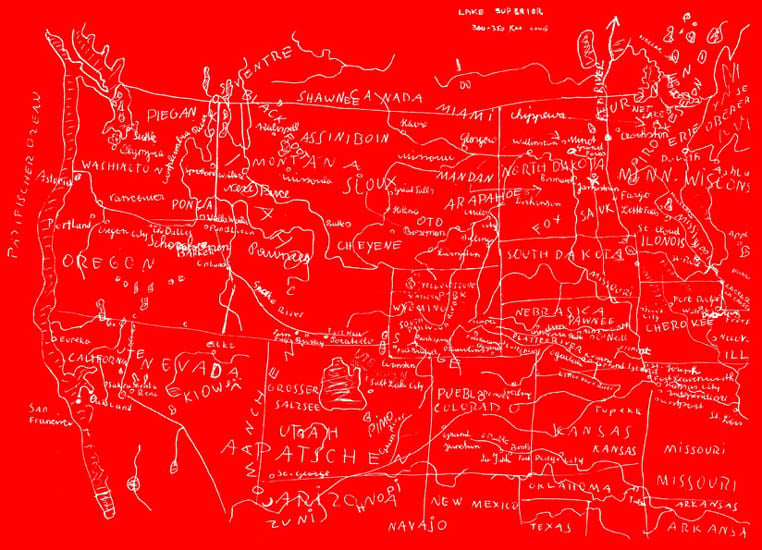The Anabasis of May and Fusako Shigenobu, Masao Adachi, and 27 Years without Images
2011 - Film & Video (Film & Video)
65 x 85 x 5 cm, film: 66 min
Eric Baudelaire
In a society saturated by images, Eric Baudelaire is interested in political events that have not found their representation. For the film The Anabasis of May and Fusako Shigenobu, Masao Adachi and 27 Years without Images, Baudelaire conducted research on 1970s Japanese cinema and more specifically on Wakamatsu and Masao Adachi’s filmography. In 1971, as the two legendary filmmakers of Japanese Nouvelle Vague were on their way home from a presentation at the Cannes festival, they stopped in Beirut, where their thinking concerning the image took the form of political activism. They made a documentary on the Palestinian struggle. Three years later, Masao Adachi became the writer for the Japanese Red Army Faction, which was linked to the PFLP (Popular Front for the Liberation of Palestine). In this film, the 30 year-long journey of the Japanese Red Army is told by two of its protagonists. As the daughter of the founder of the group, May Shigenobu was a close witness. She was born in hiding in Lebanon and only experienced being in Japan from the age of 27, after the arrest of her mother. Adachi was the theorist of fûkeiron, themovement of filmmakers who shot landscape in order to reveal the omnipresent structures of power. There are no images of his 27 years of voluntary exile since what he filmed in Lebanon was destroyed during the war on three occasions. Therefore The Anabasis of May and Fusako Shigenobu, Masao Adachi and 27 Years without Images is structured through speech, witness accounts and memory (or false memories) . The stories are intertwined and reveal complex rapports between militancy, terrorism and cinema. Thus one wonders whether, once Adachi sided with the armed struggle, he might have continued to think like a director, planning the airplane highjacking or hostage-taking as scripts where actors would be the militants and where television cameras replaced those of the filmmaker. More broadly, this film considers the role of art and the powerlessness that could lead to the shift from an artistic practice to armed struggle. It follows the shift from a cinematographic image to that of propaganda, and armed propaganda, before concentrating on the reconstruction of missing images.
Currently based in Paris, Franco-American artist Eric Baudelaire has developed an oeuvre primarily composed of film, but which also includes photography, silkscreen prints, performance, publications and installations. In his research-based practice, the artist examines the relationship between images, past events and their documentation. Interested in the role of the cinematographic image as an index marker, Baudelaire creates narratives in which recorded facts serve as a starting point for an exploration of the unknown. In examining the changes in human behavior though interrogating the great political structures that govern the global, national and micro-communities, Baudelaire’s practice could be read through a bio-political perspective. Navigating the experience of urban living, the global, technical and economic dependencies of war, movement and the contemporary paradigm of geographical proximity and distance, Baudelaire’s practice evokes a hauntingly provocative perspective on the current political climate.
Colors:
Related artist(s) to: Eric Baudelaire » Hassan Khan, » Maxim Gvinjia, » Adrián Villar Rojas, » Danh Vo, » Hito Steyerl, » Katrina Weber Ashour, » Masao Adachi, » Peter Friedl, » Rasha Salti, » Sharjah Biennial

© » KADIST
Adrian Villar Rojas
2012Based on historical prophecies and fantasy, the artist creates apocalyptic scenarios that posit an enigmatic world plagued by social, political, and environmental upheaval...

© » KADIST
Adrian Villar Rojas
2010The two drawings in the Kadist Collection are part of a larger series entitled Las Mariposas Eternas (The Eternal Butterflies)...

© » KADIST
Peter Friedl
2001Peter Friedl’s projects place aesthetic questions within an expanded field that takes into account the social, political and philosophical context...

© » KADIST
Peter Friedl
2005Map 1969-2005, a poster glued on the wall, questions space in its relation to geography...


